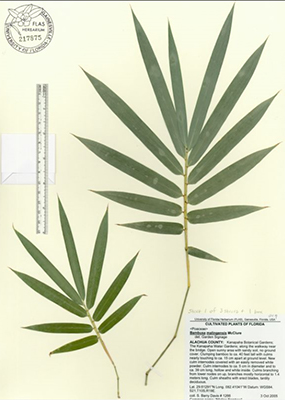Internet Resources for Checking Plant Names
 By Marc S. Frank, Extension Botanist with the UF/IFAS Plant Identification and Information Service
By Marc S. Frank, Extension Botanist with the UF/IFAS Plant Identification and Information Service
Extension agents and Master Gardener volunteers often ask me what is the best website for checking plant names. Sometimes, you just need to check the correct spelling of a plant scientific name or find out what family it is in. Other times, you see multiple scientific names used for a certain plant, and you need to find out which is currently accepted, or you're trying to determine the native distribution for a specific plant. There's a lot of misinformation out there on the internet, so you need to know which resources are most reliable. Unfortunately, there is no single website that is good for checking all plant names. I have several different websites bookmarked at the top of my web browser, so I can quickly compare them and check for consensus.
For plants that are native or naturalized (escaped from cultivation and reproducing in the wild) in Florida, the standard website is the Florida Plant Atlas, which is maintained by the Institute of Systematic Botany at the University of South Florida. You can search for a plant by typing in either the scientific name or the common name. For each of the 4000+ native/naturalized plant species in Florida, the Atlas has a webpage that provides the scientific and common names, synonyms, a map of the vouchered distribution in Florida (the counties from which herbarium specimens have been made), and, in many cases, photos. The Florida Plant Atlas does not include most of the cultivated plants that are in Florida. In some cases, this website seems to be rather conservative in adopting taxonomic or nomenclatural changes that are being published in the ongoing Flora of North America project and elsewhere.
The USDA GRIN (Germplasm Resource Information Network) website is a great resource that includes scientific and common names, synonyms, and distributional ranges. Many species profiles also include economic uses and references to relevant articles. Unfortunately, USDA GRIN somehow seems to miss a number of Florida endemics (species restricted only to Florida) and often doesn't include some of the more exotic plant species that are cultivated in Florida. It does not include any plant photos or illustrations or distribution maps.
The Plant List, which is a collaboration between the Royal Botanic Gardens, Kew, and Missouri Botanical Garden, is a working list of all known plant species. You can search by family, genus, or species, but not by common name. Each species profile includes the family, the currently accepted name, and its synonyms, but no additional distributional, taxonomic, or economic information. The Plant List aggregates data from several different sources, and on more than a few occasions I have found that they accept two different plant names for the same species. It does not always seem to keep up with changes in plant names as reflected in the most current taxonomic literature.
Not all plant families have been treated in the Flora of North America yet, but for those that are included, we generally regard them as authoritative because they are based on examination of herbarium specimens from all over the country and extensive review of the existing literature. You can search on a plant genus, species, or family, but you cannot search on common names. The Flora of North America includes keys to genera and species within the treated families, and provides detailed descriptions of plant species and their distribution within North America. There are sometimes links to distribution maps or illustrations, but no photos are provided. This is probably the most challenging website for non-botanists to use, but it is packed with really useful information.
It takes a little time to familiarize yourself with these websites and their features. I recommend that you visit each one and type in the name of a plant that you're interested in, so you can see for yourself what these websites have to offer. If you can't seem to find the answer to a question about plant names, first check with your county Master Gardener coordinator. If you still can't find the answer, contact me by email and I'll do my best to help.

